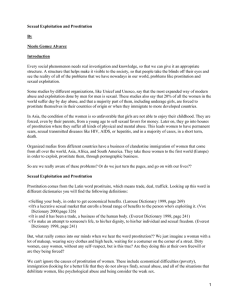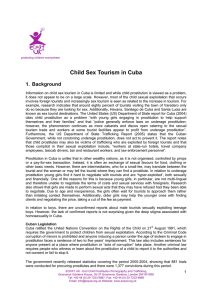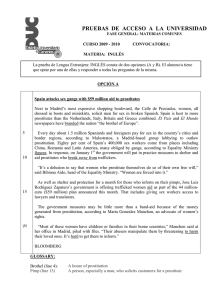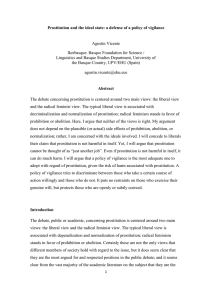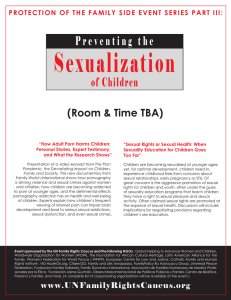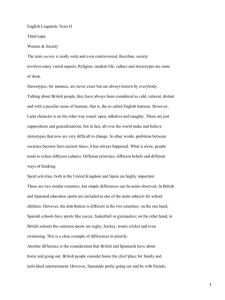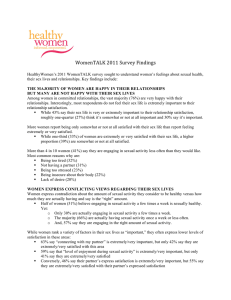Attitudes toward prostitution - The European Journal of Psychology
Anuncio
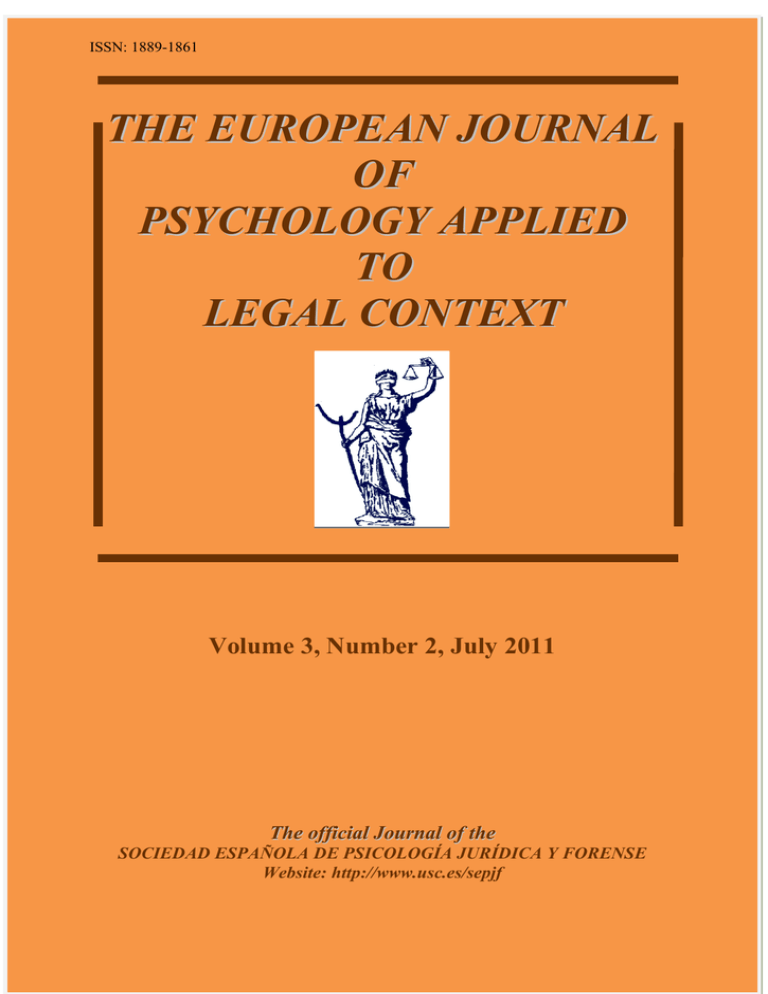
ISSN: The1889-1861 European Journal of Psychology Applied to Legal Context, 2011, 3(2) www.usc.es/sepjf j THE EUROPEAN JOURNAL OF PSYCHOLOGY APPLIED TO LEGAL CONTEXT Volume 3, Number 2, July 2011 The official Journal of the SOCIEDAD ESPAÑOLA DE PSICOLOGÍA JURÍDICA Y FORENSE Website: http://www.usc.es/sepjf The European Journal of Psychology Applied to Legal Context, 2011, 3(2) Eur. j. psychol. appl. legal context, 2011, 3(2), 89-176, ISSN: 1889-1861 www.usc.es/sepjf Editor Ramón Arce, University of Santiago de Compostela (Spain). Associate Editors Gualberto Buela-Casal, University of Granada (Spain). Francisca Fariña, University of Vigo (Spain). Editorial Board Rui Abrunhosa, University of O Miño (Portugal). Ray Bull, University of Leicester (UK). Thomas Bliesener, University of Kiel (Germany). Fernando Chacón, Complutense University of Madrid (Spain). Ángel Egido, University of Angers (France). Antonio Godino, University of Lecce (Italy). Günter Köhnken, University of Kiel (Germany). Friedrich Lösel, University of Cambridge (UK). María Ángeles Luengo, University of Santiago de Compostela (Spain). Eduardo Osuna, University of Murcia (Spain). Ronald Roesch, Simon Fraser University (Canada). Francisco Santolaya, President of the Spanish Psychological Association (Spain). Juan Carlos Sierra, University of Granada (Spain). Jorge Sobral, University of Santiago de Compostela (Spain). Max Steller, Free University of Berlin, (Germany). Francisco Tortosa, University of Valencia (Spain). Peter J. Van Koppen, Maastricht University (The Netherlands). Indexation ISOC DICE DOAJ DIALNET DIE ELEKTRONISCHE ZEITSCHRIFTENBIBLIOTHEK (EZB) ACPN GOOGLE SCHOLAR ULRICHS WEB LATINDEX REFDOC EBSCO PASCAL Official Journal of the Sociedad Española de Psicología Jurídica y Forense (www.usc.es/sepjf) Published By: SEPJF. Published in: Santiago de Compostela (Spain) Volume 3, Number 2. Order Form: see www.usc.es/sepjf Frequency: 2 issues per year (January, July). E-mail address: ejpalc@usc.es Postal address: The European Journal of Psychology Applied to Legal Context, Facultad de Psicología, Universidad de Santiago de Compostela, E-15782 Santiago de Compostela (Spain). ISSN: 1889-1861. D.L.: C-4376-2008 The European Journal of Psychology Applied to Legal Context, 2011, 3(2): 159-176 www.usc.es/sepjf ATTITUDES TOWARD PROSTITUTION: IS IT AN IDEOLOGICAL ISSUE? Inmaculada Valor-Segura, Francisca Expósito, and Miguel Moya Universidad de Granada (España) (Received 1 December 2010; revised 20 April 2011; accepted 25 April 2011) Abstract Prostitution has been the subject of intense debate in all societies and cultures though to varying degrees of public acceptance or rejection. The choice of legal approach to deal with this issue (i.e., legalization or prohibition) may be influenced by ideological factors. The primary aim of this study was to assess, in a sample of 620 individuals drawn from general population, the legal stances towards prostitution, and attitudes and beliefs regarding the underlying motives and behaviour of men who resort to prostitution. Moreover, the effects of sexist attitudes and beliefs and the legal stance towards prostitution on victimblaming in cases of physical or sexual assault to prostitutes were assessed. The results reveal significant differences in legal stance towards prostitution in relation to attitudes and beliefs concerning the underlying motives and behaviour of men who procure the services of a prostitute. In other words, a high score in prohibition was associated to hostile attitudes and belief regarding the behaviour of men who resort to prostitution whereas a high score in legalization predicted benevolent attitudes and beliefs towards these men. Furthermore, the results show that a high degree of hostile sexism and the legal stance of prohibition predicted victimblaming in physical or sexual assault to prostitutes. Keywords: Prostitution, Ideology, Sexism, Prohibition, Legalization, Attitudes. Resumen La prostitución constituye uno de los problemas tradicionales presentes en todas las sociedades y culturas con mayor o menor aceptación pública. La medida legal que se adopte ante esta problemática (legalización o prohibición) puede estar determinada por la influencia de factores ideológicos. El objetivo fundamental de la presente investigación, a través de un total de 620 participantes de población general, consistió en indagar la postura legal ante la prostitución y las creencias del comportamiento del hombre que accede a estas prácticas. A su vez, se analizó el efecto de las creencias sexistas y de la postura legal en la culpabilización de la víctima ante un abuso físico o sexual. Los resultados muestran diferencias de la medida legal en el tipo de creencias que se tienen acerca del hombre que consume prostitución. De modo que la puntuación alta en prohibición se relaciona con una creencia hostil acerca del comportamiento del hombre y una puntuación alta en legalización predice una creencia benévola hacia el hombre que acude a una prostituta. A su vez, los resultados muestran que mayores niveles de sexismo hostil y una postura prohibicionista hacia la prostitución predicen la culpabilización de la mujer prostituta si su cliente abusa de ella. Palabras clave: Prostitución, Ideología, Prohibición, Legalización, Actitudes. Sexismo, Correspondence: Inmaculada Valor-Segura, Departamento de Psicología Social y Metodología de las Ciencias del Comportamiento, Facultad de Psicología, Universidad de Granada, Campus de Cartuja, 18071, Granada, España. E-mail: ivalor@ugr.es ISSN 1889-1861 © The European Journal of Psychology Applied to Legal Context 160 I. Valor-Segura et al. Introduction In recent decades Spain has witnessed, as in other European countries, a considerable increase in prostitution, and a parallel increase in the trafficking of women for sexual exploitation (Solana, 2005). Though prostitution is commonly referred to as “the oldest profession in the world”, the scientific literature on this issue is scarce (Della Giusta, Di Tommaso, & Strøm, 2009). Prostitution is defined as “an activity whereby a person offers sexual relations in exchange of payment of money" (Real Academia Española, 2001). Since prostitution primarily involves women, the variable gender is a salient factor for analysis. The issue of prostitution can be approached from multiple perspectives, each of which defines how the procurement of sex is understood i.e., as a public health issue, a legal dilemma, a question of personal choice, ethical or moral issues, in terms of gender violence or as a violation of human rights (Montañés & Moyano, 2006). Several recent studies have focused on public health risks and the use of condoms among prostitutes (Cunha & Chaves, 2008; Rao, Gupta, Lokshin, & Jana, 2003; Willman, 2008); the association between prostitution and Postraumatic Stress Disorder (PTSD) (Sullivan, 2007; Zumbeck, Teegen, Dahme, & Farley 2003) or the incidence of illegal substance abuse among prostitutes (Burnette, Schneider, Timko, & Ilgen, 2009). Notwithstanding, few studies have sought to examine the attitudes and beliefs of the general public towards prostitution (Basow & Campanile, 1990; Polk & Cowan, 1996). Approaches to prostitution vary from one country to another, ranging from legalization to prohibition (Hubbard, Matthews, & Scoular, 2008; Jakobsson & Kotsadam, 2011; Weitzer, 2010), and a host of socio-judicial policies have been proposed to deal with prostitution. On the one hand, prohibition is based on the premise that sex trafficking is an essential component of prostitution, thus sex cannot be legally bought or sold (Weitzer, 2010). From this perspective prostitution is conceived as modern-day slavery (Mathieu, 2011); thus, prostitution should be decriminalized and the prostitute should be treated as a victim (Ekberg, 2004). Certain penal codes exclusively typify the behaviour of those who seek financial gain from coercing women into prostitution or “clients” who procure the services of prostitutes. This approach has The European Journal of Psychology Applied to Legal Context, 2011, 3(2): 159-176 Attitudes toward prostitution 161 been adopted by Sweden´s 1999 law that penalizes the client with fines and a maximum six-month prison sentences. Swedish law is grounded in the belief that women are always or nearly always forced into prostitution by organized crime or due to adverse social circumstances and/or financial hardship. Thus, policies aimed at eliminating the sex trade should not seek to penalize the weak i.e., the victim (women and young girls), but those who traffic women for sexual exploitation, and those who procure their service as mere sexual objects (Ekberg, 2004). In contrast, legalization has been the approach enforced by countries such as Holland, Greece, and Turkey (Outshoorn, 2001, 2005). The underlying premise is that prostitution is simply inevitable and a question of free will, thus it should be admitted by society. Consequently, sex workers should undergo periodic health checkups and controls and enjoy the same rights as any other worker. From the prohibitionist point of view, prostitution is conceived in terms of gender violence and violation of human rights (Ekberg, 2004; Giobbe, Harrigan, Ryan, & Gamache, 1990; Valor-Segura & Expósito, 2008), and is viewed as the epitome of male dominance and the exploitation of women regardless of the historical period, social context or the type of prostitution (Weitzer, 2005). Mainstream attitudes and beliefs that justify prostitution not only promote and reinforce erroneous depictions of prostitutes, but also of women as a whole (Cotton, Farley, & Baron, 2002). This approach aims to eradicate sex trafficking by removing regulations on prostitution. Moreover, proponents of legalizing prostitution argue that labelling prostitutes as “victims” only leads to further alienation and gender violence, and hinders their demands for equal rights as sex workers (Holgado, 2001; Raymond, 2004). This ideology postulates that prostitutes are legitimate sex workers and that prostitutes prefer this term themselves (Kurtz, Surratt, Inciardi, & Kiley, 2004). Though it is commonly assumed that under certain circumstances prostitutes are subject to deception and cohesion, there remains widespread acceptance of the belief that most prostitutes voluntarily practice their profession in the knowledge that other professions do not reap the same financial rewards (Ferrer, 2001). Regardless of the disparity in perspectives regarding prostitution i.e., a profession or a violation of human rights, research undertaken in several countries (e.g., USA, South Africa, Thailand, Turkey, and Zambia) has revealed that a large number of The European Journal of Psychology Applied to Legal Context, 2011, 3(2): 159-176 162 I. Valor-Segura et al. women who are or have been prostitutes have suffered physical or sexual violence and Posttraumatic Stress Disorder (PTSD) (Falcón, 2000; Farley, Baral, Kiremire, & Sezgin, 1998; Farley & Barkan, 1998; Giobbe, 1993; Hunter, 1994; Miller, 1995; Silbert & Pines, 1984; Sullivan, 2007; White & Koss, 1993; Zumbeck et al., 2003). The impact of prostitution is not circumscribed to prostitutes alone, and conditions social attitudes and beliefs towards all women, and reinforces traditional gender roles (Bernardo, 2001). Gender equality is deeply rooted in a long history of beliefs about the biological differences between men and women, and the innateness of male supremacy, both being fundamental tenets for justifying male domination of women (Expósito & Moya, 2005). Sexism serves to justify and reinforce gender inequality, and has traditionally degraded women by expounding that it is convenient to excersize some dominance over them, and that it is legitimate to force women into submission and restricit their roles and rights. The Theory of Ambivalent Sexism, proposed by Glick and Fiske (1996), postulates that sexism is ambivalent because it is formed by two clearly differentiated, yet related, components: benevolent sexism and hostile sexism. Though the former refers to positive but nonetheless sexist attitudes towards women in as much as they are stereotypes, it is associated to affection and prosocial behaviour e.g., help or the search for intimacy (Glick & Fiske, 1996). In contrast, hostile sexism legitimizes violence against women who dare challenge the male supremacy of the men who “sexually exploit” them or those who “stain” male honour. Benevolent sexism, in comparison, legitimizes negative reactions towards women who refuse to conform to traditional gender roles or “step out of line”, and prostitutes do not qualify to be under the umbrella of “protective paternalism”. Both hostile and benevolent sexism influence attitudes and beliefs towards prostitution, and the justification of gender violence towards women. Several studies have examined the relationship between sexism and several aspects of gender violence such as the incidence of rape and victim-blaming (Abrams, Viki, Masser, & Bohner, 2003), tolerance to sexual assaults (Russell & Trigg, 2004) or the justification of cases of domestic violence (Valor-Segura, Expósito, & Moya, 2008). As for the prevalence of prostitution, The Swedish National Institute of Public Health has estimated that one out of every eight men has paid for sex at least once in their lives. According to a survey on health and healthy habits undertaken in Spain, 26% of men aged 18 to 49 years had at some time paid for the services of a prostitute The European Journal of Psychology Applied to Legal Context, 2011, 3(2): 159-176 Attitudes toward prostitution 163 (Instituto Nacional de Estadística de España, 2003). What are the social circumstances and motives that lead men to seek the services of a prostitute? Much of the evidence obtained from studies designed to tackle this question is weak or inconclusive, and there is considerable disparity in the results reported (Atchison, Fraser, & Lowman, 1998). Paying for sex has been defined in terms of deviant behavior of a psychopathological nature. Recent studies, however, have normalized the image of the client and his motives for paying for sex in relation to the macro and micro social context (Meneses, 2010). Social constructions of men and women´s sexuality have contributed to generating the myth of the “natural urge” of men to satisfy their sexual impulses. Consequently, it is commonly assumed that prostitution is a legitimate outlet for lonely or single men with uncontrollable sexual drives (Association for the Rehabilitation of Women Prostitutes, 2005). Several typologies of men who procure the services of a prostitute have been proposed with categories such as: men dissatisfied with existing relationships, lonely men motivated by sexual needs (Manson, 1993); men who desire sexual practices they cannot request from a regular partner or that their regular partners refuse to provide (McKeganey, 1994; Monto, 2001); and men who want to exercise control of sexual relations, or as an expression of male dominance (Atchinson et al., 1998; Monto, 2004; Volnovich, 2006). Bearing in mind the multiplicity of perspectives, the primary aim of this study was to assess the legal stance towards prostitution, and the attitudes and beliefs regarding the motives underlying the behaviour of men who resort to prostitution. We hypothesised that respondents who favoured prohibition would harbour hostile attitudes and beliefs towards the behaviour of men who procure the services of prostitutes. In comparison, respondents who favoured legalization would have benevolent attitudes and beliefs concerning the behaviour of these men. A further objective was to assess the impact of sexist attitudes and beliefs, and the choice of legal stance on victim-blaming in physical or sexual assaults on prostitutes. Hostile sexism and prohibition were expected to predict greater victim-blaming in physical or sexual assaults on prostitutes. The European Journal of Psychology Applied to Legal Context, 2011, 3(2): 159-176 164 I. Valor-Segura et al. Method Participants Initially, the sample consisted of 659 participants of whom 39 women were excluded for giving several invalid or inconsistent responses and/or their unwillingness to cooperate. Thus, a total of 620 participants, 40% men and 60% women aged 14 to 66 years, mean age 26.69 years (SD = 10.53), participated in the study. As for academic status, 9% had completed Primary Education, Compulsory Secondary Education, 10.3 % Elementary Baccalaureate, 28.5% Higher Baccalaureate, 7.1% Vocational Studies, and 44.7% were University Graduates. In relation to employment status, 21.3% were full-time workers, 33.2% part-time or seasonal workers and the remaining 45.5% were unemployed. Procedure and Design The selection of the stratified random sample for gender and academic status was undertaken in the city of Jaén (southern Spain) by a team of previously trained researchers. All participants freely consented to participating in the study and were informed their responses and data would remain anonymous and confidential. Variables and measurement instruments The measurement instrument consisted of a battery of questionnaires that included the following: Sociodemographic characteristics: sex, age, academic qualifications (Primary Education, Compulsory Secondary Education, Elementary Baccalaureate, Higher Baccalaureate, Vocational studies, and University graduates), and employment status: full-time worker, part-time, seasonal worker or unemployed. The Scale of the Legal Stance towards Prostitution (Valor-Segura & Expósito, 2008; Valor-Segura, Expósito, & Moya, 2011) is a 10-item self-report measure of attitudes and beliefs towards prostitution and different legal approaches. Respondents indicate their level of agreement with various statements, which are placed on a 5-point likert-type scale where 1 expresses total disagreement, and 5 total agreement. An example of the items on the scale is “I think prostitution should be prohibited”; “I think The European Journal of Psychology Applied to Legal Context, 2011, 3(2): 159-176 Attitudes toward prostitution 165 that legalizing prostitution, like Holland, is the best policy for solving the problem of women trafficking and for the sex industry as a whole”, etc. The poles of the scale were Legalization (associated to low scores), and Prohibition (linked to higher scores on the scale). The items that evaluated in the opposite direction were redirected. The Cronbach's alpha coefficient of the scale was .82, which is similar to the internal consistency obtained in other studies (Valor-Segura et al., 2011). The Ambivalent Sexism Inventory (Expósito, Moya, & Glick, 1998; Glick & Fiske, 1996) is a 22-item self-report measure of sexism requiring respondents to indicate their level of agreement with various statements, which are placed on a 6-point likert-type scale. The inventory consists of two subscales i.e., hostile sexism with 11 items designed to assess dominant paternalism (e.g., “Women are too easily offended”, “Women seek power by gaining control over men”), and benevolent sexism with 11 items (e.g., “Women should be cherished and protected by men”, “In case of a catastrophe, women should be saved before men”). The total alpha coefficient was .91 for the entire scale, .90 for the hostile subscale, and .85 for the benevolent subscale. Drawing on the typology of the motives and behaviour of men who resort to prostitution (Atchinson et al, 1998; Mansson, 1993; McKeganey, 1994; Monto, 2004; Volnovich, 2006), a scale to measure Beliefs concerning the motives and behaviour of men who pay for sex (Valor-Segura, Expósito, & Moya, 2009) has been designed with six items. Of these, three items measured hostile beliefs towards the motives and behaviour of men who pay for sex (e.g., I think men go to prostitutes because “men only want to enjoy themselves”, “men like to dominate women”), and the remaining three items benevolent beliefs (e.g., I think men go to prostitutes because “they feel lonely”, “they are in need of love”). Respondents were required to indicate the degree of agreement/disagreement with various statements placed on a 7-point likert-type scale where 1= indicates disagreement, and 7= total agreement). In order to measure the incidence of victim-blaming in physical or sexual assaults on prostitutes, the participants responded to the following questions: “To what extent is a prostitute responsible for being physically assaulted by a man?”, and “To what extent is a prostitute responsible for being sexually assaulted by a man?” A 7-point Likert type scale was used where 1 indicated “no blame at all” and 7 “all the blame”. The European Journal of Psychology Applied to Legal Context, 2011, 3(2): 159-176 166 I. Valor-Segura et al. Results The relationship between the legal stance towards prostitution and attitudes and beliefs concerning the motives and behaviour of men who pay for sex. In order to explore the uni- and multi-dimensionality of the legal stance towards prostitution, factor analysis using the principal components method was performed that revealed the items were grouped in one factor alone as shown by Cattell´s criterion (see Graph 1) and Kaiser-Guttman (eigenvalues greater than one). A total of three items were eliminated for failing to meet the Discrimination Index .20 cut-off. The indices of the remaining items were acceptable (the lowest being .41) given that values above .40 are considered to be good indicators of discrimination (Ebel, 1965). 4 3 2 Eigenvalues 1 0 1 2 3 4 5 6 7 Factor number Graph 1. Sedimentation graph of the scale of the legal stance towards prostitution The remaining seven items were submitted to further exploratory factorial analysis, using extraction of the principal components method. Both the Kaiser-Meyer Olkin measure of sample adequacy (.82), and Bartlett's sphericity test, χ2(21) = 1275.58; p < .001, support the relevance of an exploratory factor analysis. The data of the factorial analysis (see Table 1) reveal that one dimension alone explained 47.4% of the The European Journal of Psychology Applied to Legal Context, 2011, 3(2): 159-176 167 Attitudes toward prostitution total variance. Scale reliability, as measured by the α coefficient, was .82, which can be considered satisfactory bearing in mind the small number of items on the scale. Table 1. Factor analysis of the scale on the legal stance to prostitution. ITEMS 1. Creo que la prostitución ha de ser erradicada 2. Considero que la prostitución como un grave problema social 5. En nuestro país se deberían adoptar medidas de abolicionismo como en Suecia, donde la prostitución es considerada como un acto de violencia y el castigo va dirigido al cliente 7. La prostitución es uno de los trabajos más antiguos del mundo y no debería eliminarse (R) 6. La mejor medida para solucionar los problemas que causa la prostitución sería castigar a la prostituta y al cliente que pide los servicios de la prostitución 4. Considero que legalizar la prostitución, como en Holanda, es la mejor política que se puede adoptar para resolver el problema de tráfico de mujeres y el mercado del sexo (R) 3. Las medidas que se deberían adoptar por ley, para solucionar los problemas que causa la prostitución, deberían ir encaminadas a castigar a la persona que se prostituye Factor loadings .78 .71 % of the explained variance Eigenvalues Cronbach´s Alpha Note. (R) These items invert their score. .67 .60 .59 .51 .44 47.41 3.32 .82 Thus, the resulting one-dimensional scale for evaluating the legal stance towards prostitution consisted of two polar opposites i.e., Legalization (correlated to low scores) and Prohibition (correlated to high scores). In order to assess the legal stance towards prostitution, and the attitudes and beliefs regarding the motives underlying the behaviour of men who resort to prostitution, the sample was subdivided into three groups according to the scores obtained on the scale, the criterion for segmentation being the tercile value. Thereafter, low scoring subjects (associated to Legalization), and high scoring subjects (associated to Prohibition) were selected and the group of intermediate scores was eliminated which a reduced the sample for analysis to 425 individuals. The opposing groups were then used as a factor to measure differences in the independent samples, with hostile and benevolent attitudes and beliefs about the behaviour of men as dependent variables. The comparison of the data obtained for both groups reveal the greater association of prohibition (M = 5.43, SD = 1.18) to hostile attitudes and beliefs towards the behaviour of men, t(423) = - 4.354, p < .001, than legalization (M = 4.94, SD = 1.13). Moreover, The European Journal of Psychology Applied to Legal Context, 2011, 3(2): 159-176 168 I. Valor-Segura et al. significant statistical differences were found for benevolent beliefs of the behaviour men, t(423) = 2.011, p < .05, with legalization (M = 4.59, SD = 1.25) with scores higher than for prohibition (M = 4.34, SD = 1.36). The impact of sexist attitudes and beliefs and the legal stance towards prostitution on victim-blaming in physical or sexual assault on prostitutes. A further aim of this study was to assess the impact of sexist attitudes and beliefs and the legal stance towards prostitution on victim-blaming in physical or sexual assaults to prostitutes. To determine the best predictor variables of victim-blaming in physical and sexual assault to prostitutes, two multiple regression analysis were performed. The predictor variables used were the total scores on the scale of the legal stance towards prostitution, the total hostile sexism score, and the benevolent sexism score. Variables were added to the regression equation in a stepwise manner. The dependent variables were the victim-blaming scores for physical or sexual assault to prostitutes. In the case of victim-blaming in sexual assault, the explanatory variables were the total score for legal stance towards prostitution and the hostile sexism score. These variables also appear in the predictive model for victim-blaming in physical assault (see Table 2 for details on the load of the predictor variables in both models). Table 2. Linear regression analysis of the predictor variables of victim-blaming physical o sexual assaults to prostitutes Variables B β t p R2 F gl1/gl2 Constant -.703 -2.951 .003 Legal Sexual stance to .090 .337 8.539 .000 .198 76.514 2/608 assault prostitution Hostile .384 .273 6.793 .000 Sexism Constant -.435 1.949 .050 Legal Physical stance to .077 .316 8.539 .000 .171 64.103 2/608 assault prostitution Hostile .326 .251 6.793 .000 Sexism in p .000 .000 Table 2 shows that hostile sexism and the legal stance to prostitution were the best variables to predict the tendency to victim-blame in physical or sexual assault to prostitutes. As expected, the tendency was to victim-blame the prostitute in instances of The European Journal of Psychology Applied to Legal Context, 2011, 3(2): 159-176 Attitudes toward prostitution 169 physical or sexual assault when men have a hostile ideology towards women and support the prohibition of prostitution. Discussion The results of this study reveal that men who wish to outlaw prostitution have hostile beliefs concerning the motives and behaviour men who pay for sex (a man who likes to dominate women or has an insatiable sexual appetite). In comparison, men who favour the legalization of prostitution assert it is an escape valve for single men or for those who have voracious sexual appetites (Association for the Rehabilitation of Women Prostitutes, 2005), and hold benevolent beliefs about the motives and behaviour of men who pay for sex. The key objective of this study was to assess the impact of sexist ideology and legal stances towards prostitution on the appraisal of violence towards prostitutes. The results reveal that the tendency to victim-blame prostitutes is greater among people who harbour a hostile ideology towards women (hostile sexism), and favour the prohibition of prostitution. In contrast, people who favour legalization tend to conceive of prostitutes as sex workers, and do not tend to victim-blame the prostitute for physical or sexual assaults by men. The literature on prostitution in relation to public health risks, illegal substance abuse, HIV/AIDS, and Posttraumatic Stress Disorder (PTSD) (Burnette et al., 2009; Cunha & Chaves, 2008; Rao et al., 2003; Sullivan, 2007; Willman, 2008) is extensive. Notwithstanding, few studies have sought to examine the attitudes and beliefs of the general population towards prostitution (Basow & Campanile, 1990; Polk & Cowan, 1996). Basow and Campanile (1990) found a correlation between feminist ideology and attitudes against prostitution. Polk and Cowan (1996) found their sample of students widely accepted the belief that prostitutes enjoyed and were proud of their job, liked sex, and had high self-esteem. Prostitution is a complex and controversial issue that is immersed in the wider gender inequality pervasive in society, thus one should be cautious in drawing conclusions. Nevertheless, we may conclude that sexist ideology, attitudes and beliefs towards prostitution influence how prostitutes are depicted and the justification of The European Journal of Psychology Applied to Legal Context, 2011, 3(2): 159-176 170 I. Valor-Segura et al. physical or sexual assaults on prostitutes. Thus, violent behaviour towards women was associated to culturally reinforced attitudes and beliefs that men have the right to sexually access women, feel superior to them, and that sexual abuse can be justified (Cotton et al., 2002). Regardless of the debate on whether prostitution is a job or a violation of human rights (Farley, 2000, 2001, 2004; Farley & Kelly, 2000), there is sufficient data to conclude that prostitution is not an expression of a woman´s sexual freedom, but rather the plight of prostitutes is associated to physical and sexual assault, alienation, economic hardship, and the degradation of a sexist and patriarchal culture that has dominated women since time immemorial. References Abrams, D., Viki, G. T., Masser, B., & Bohner, G. (2003). Perception of a stranger and acquaintance rape: The role of benevolent and hostile sexism in victim blame and rape proclivity. Journal of Personality and Social Psychology, 84, 111-125. doi: 10.1037/0022-3514.84.1.111 Association for the Rehabilitation of Women Prostitutes. (2005). La prostitución. Claves básicas para reflexionar sobre un problema [Prostitution. Basic cues to think about a problem]. Retrieved from http://www.apramp.org/upload/doc8_MAQUETA%20APRAMP%20DEFINITI VA.pdf Atchison, C., Fraser, L., & Lowman, J. (1998). Men who buy sex: Preliminary findings of an exploratory study. In J. Elias, V. Bullough, V. Elias, & G. Brewer (Eds.), Prostitution (pp. 172- 203). Amherst, NY: Prometheus. Basow, S. A., & Campanile, F. (1990). Attitudes toward prostitution as a function of attitudes toward feminism in college students. Psychology of Women Quarterly, 14, 135-141. doi: 10.1111/j.1471-6402.1990.tb00009.x Bernardo, S. (2001). Mujer e inmigración [Woman and immigration]. Revista Aequalitas: Revista Jurídica de Igualdad de Oportunidades entre Hombres y Mujeres, 6, 34-36. The European Journal of Psychology Applied to Legal Context, 2011, 3(2): 159-176 Attitudes toward prostitution 171 Burnette, M. L., Schneider, R., Timko, C., & Ilgen, M. A. (2009). Impact of substanceuse disorder treatment on women involved in prostitution: Substance use, mental health, and prostitution one year after treatment. Journal of Studies on Alcohol and Drugs, 70, 32-40. Cunha, M., & Chaves, C. (2008). Prostitution and AIDS. Psychology & Health, 23, 15278. doi: 10.1080/08870440802299543 Cotton, A., Farley, M., & Baron, R. (2002). Attitudes toward prostitution and acceptance of rape myths. Journal of Applied Social Psychology, 32, 1790-1796. doi: 10.1111/j.1559-1816.2002.tb00259.x Della Giusta, M., Di Tommaso, M. L., & Strøm, S. (2009). Who is watching? The market for prostitution services. Journal of Population Economics, 22, 501-516. doi 10.1007/s00148-007-0136-9 Ebel, R. L. (1965). Measuring educational achievement. Englewood Cliffs, NJ: Prentice-Hall. Ekberg, G. (2004). The Swedish Law that prohibits the purchase of sexual services. Violence against Women, 10, 1187-1218. doi:10.1177/1077801204268647 Expósito, F., & Moya, M (2005). Violencia de género [Gender violence]. In F. Expósito & M. Moya (Eds.), Aplicando la psicología social (pp. 201-227). Madrid: Pirámide. Expósito, F., Moya, M., & Glick, P. (1998) Sexismo ambivalente: Medición y correlatos [Ambivalent sexism: Measurement and correlates]. Revista de Psicología Social, 13, 159-170. doi:10.1174/021347498760350641 Falcón, L. (2000). Mirar ardiente y desgarrado [A passionate and heart-breaking look]. Madrid: Vindicación Feminista. Farley, M. (2000). Prostitution: Factsheet on human rights violations. San Francisco, CA: Prostitution Research and Education. Farley, M. (2001). Prostitution. The business of sexual explotation. In J. Worell (Ed.), Encyclopedia of women and gender (pp. 879-891). San Diego, CA: Academic Press. The European Journal of Psychology Applied to Legal Context, 2011, 3(2): 159-176 172 I. Valor-Segura et al. Farley, M. (2004). Bad for the body, bad for the heart: Prostitution harms women even if legalized or decriminalized. Violence against Women, 10, 1087-1125. doi: 10.1177/1077801204268607 Farley, M., Baral, I., Kiremire, M., & Sezgin, U. (1998). Prostitution in five countries: Violence and post-traumatic stress disorder. Feminism and Psychology, 8, 405426. doi:10.1177/0959353598084002 Farley, M., & Barkan, H. (1998). Prostitution, violence, and posttraumatic stress disorder. Women & Health, 27(3), 37-49. doi: 10.1300/J013v27n03_03 Farley, M., & Kelly, V. (2000). Prostitution. Women and Criminal Justice, 11, 20-64. doi: 10.1300/J012v11n04_04 Ferrer, A. (2001, July). Trabajadoras sexuales colombianas en Castellón. Un acercamiento a su realidad cotidiana [Colombian sex workers in Castellón. An approximation to their everyday lives]. Paper presented at the V Jornadas de Sexología de Valencia. Valencia, Spain. Giobbe, E. (1993). An analysis of individual, institutional and cultural pimping. Michigan Journal of Gender and Law, 1, 33-57. Giobbe, E., Harrigan, M., Ryan, J., & Gamache, D. (1990). Prostitution: A matter of violence against women. Minneapolis, MN: Whisper. Glick, P., & Fiske, S. T. (1996). The Ambivalent Sexism Inventory: Differentianing hostile and benevolent sexism. Journal of Personality and Social Psychology, 70, 491-512. doi:10.1037/0022-3514.70.3.491 Holgado, I. (2001). Las nuevas retóricas de la inmigración femenina: La prostitución en las calles de Barcelona [The modern rhetoric of female immigration: Prostitution on the streets of Barcelona]. Scripta Nova. Revista Electrónica de Geografía y Ciencias Sociales, 94(100). Retrieved from http://www.ub.edu/geocrit/sn-94100.htm Hubbard, P., Matthews, R., & Scoular, J. (2008). Regulating sex work in the EU: Prostitute women and the new space of exclusion. Gender, Place and Culture, 15, 137-152. doi:10.1080/09663690701863232 The European Journal of Psychology Applied to Legal Context, 2011, 3(2): 159-176 173 Attitudes toward prostitution Hunter, S. K. (1994). Prostitution is cruelty and abuse to women and children. Michigan Journal of Gender and Law, 1, 1-14. Instituto Nacional de Estadística. (2003). Encuesta de salud y hábitos saludables. Informe general [Survey on health and healthy habits. General Report]. Madrid: Instituto Nacional de Estadística. Jakobsson, N., & Kotsadam, A. (2011). Gender equity and prostitution: An investigation of attitudes in Norway and Sweden. Feminist Economist, 17, 3158. Kurtz, S., Surratt, H., Inciardi, J., & Kiley, M. (2004). Sex work and date violence. Violence against Women 10, 357–385. doi:10.1177/1077801204263199 Mansson, S. A. (1993). Cultural conflict and the Swedish sexual myth: The male immigrant’s encounter with Swedish sexual and cohabitation culture. Westport, CT: Greenwood Press. Mathieu, L. (2011). Neighbors´ anxieties against prostitutes´ fears: Ambivalence and repression in the policing of streets prostitution in France. Emotion, Space and Society. Advance online publication. doi:10.1016/j.emospa.2010.12.002 McKeganey, N. (1994). Why do men buy sex and what are their assessments of the HIV related risks when they do? AIDS Care, 6, 1-14. Meneses, C. (2010). Factores motivacionales en una muestra de hombres españoles que pagan por servicios sexuales [Motivational factors in a sample of Spanish men who pay for sex]. Revista de la Asociación Española de Neuropsiquiatría, 30, 393-407. Miller J. (1995). Gender and power on the streets: Street prostitution in the era of crack cocaine. Journal of Contemporary Ethnography, 23, 427-452. doi:10.1177/089124195023004002 Montañés, P., & Moyano, M. (2006). Violencia de género sobre inmigrantes en España. Un análisis psicosocial [Gender violence on immigrants in Spain. A psychosocial analysis]. Pensamiento Psicológico, 6, 21-32. Monto, M. (2001). Prostitution and fellatio. The Journal of Sex Research, 38, 140-145. doi: 10.1080/00224490109552081 The European Journal of Psychology Applied to Legal Context, 2011, 3(2): 159-176 174 I. Valor-Segura et al. Monto, M. (2004). Female prostitution, customers, and violence. Violence against Women, 10, 160-168. doi:10.1177/1077801203260948 Outshoorn, J. (2001). Debating prostitution in parliament. European Journal of Women's Studies, 8, 472-490. doi: 10.1177/135050680100800405 Outshoorn, J. (2005). The political debates on prostitution and trafficking of women. Social Politics, 12, 141-155. doi: 10.1093/sp/jxi004 Polk, R. K., & Cowan, G. (1996). Perceptions of female pornography stars. Canadian Journal of Human Sexuality, 5, 221-229. Rao, V., Gupta, I., Lokshin, M., & Jana, S. (2003). Sex workers and the cost of safe sex: The compensating differential for condom use among Calcutta prostitutes. Journal of Development Economics, 71, 585-603. doi:10.1016/S03043878(03)00025-7 Raymond, J. (2004). Prostitution on demand: Legalizing the buyers as sexual consumers. Violence against Women, 10, 1156-1186. doi:10.1177/1077801204268609 Real Academia Española. (2001). Diccionario de la lengua española [Dictionary of the Spanish language] (22nd ed.). Madrid: Espasa Calpe. Russell, B. L., & Trigg, K. Y. (2004). Tolerance of sexual harassment: An examination of gender differences, ambivalent Sexism, social dominance, and gender roles. Sex Roles, 50, 565-573. doi:10.1023/B:SERS.0000023075.32252.fd Silbert, M., & Pines, A. (1984). Pornography and sexual abuse of women. Sex Roles, 10, 857-868. doi: 10.1007/BF00288509 Solana, J. L. (2005). Mujer inmigrante y prostitución: Falencias y realidades [Immigrant women and prostitution: Fallacies and realities]. In F. Checa-Olmos (Ed.), Mujeres en el camino: El fenómeno de la migración femenina en España (pp. 221-257). Barcelona: Icaria Editorial. Sullivan, B. (2007). Rape, prostitution and consent. Australian and New Zealand Journal of Criminology, 40, 127-142. doi: 10.1375/acri.40.2.127 The European Journal of Psychology Applied to Legal Context, 2011, 3(2): 159-176 175 Attitudes toward prostitution Valor-Segura, I., & Expósito, F. (2008). La violación de derechos humanos más antigua del mundo: La prostitución [The oldest violation of human rights in the world: Prostitution]. In F. J. Rodríguez, C. Bringas, F. Fariña, R. Arce, & A. Bernardo (Eds.), Psicología jurídica. Familia y victimología (pp. 363-371). Oviedo: Ediciones de la Universidad de Oviedo. Valor-Segura, I., Expósito, F., & Moya, M. (2008). Atribución del comportamiento del agresor y consejo a la víctima en un caso de violencia doméstica [Attribution of the perpetrator’s behavior and advice to the victim in an episode of domestic violence]. Revista de Psicología Social, 23, 171-180. doi:10.1174/021347408784135896 Valor-Segura, I., Expósito, F., & Moya, M. (2009, July). Political ideology and legitimizing beliefs about inequality as predictors of legal position toward prostitution. Paper presented at the ISPP 32nd Annual Scientific Meeting, Dublin, Ireland. Valor-Segura, I., Expósito, F., & Moya, M. (2011, April). Elección o condena? Prejuicio y percepción social de la prostitución [Free will or tragic fate? Social prejudice and perceptions of prostitution]. Paper presented at the VI Congreso de Psicología Jurídica y Forense, Mallorca, Spain. Volnovich, J. C. (2006). Ir de putas. Reflexiones acerca de los clientes de la prostitución [Let´s go whoring. Reflections on the clients of prostitution]. Buenos Aires: Topía Editorial. Weitzer, R. (2005). Flawed theory and method in studies of prostitution. Violence against Women, 11, 934-949. doi:10.1177/1077801205276986 Weitzer, R. (2010). The movement of criminalize sex work in the United States. Journal of Law and Society, 37, 61-84. doi: 10.1111/j.1467-6478.2010.00495.x White, J. W., & Koss, M. P. (1993). Adolescent sexual aggression within heterosexual relationships: prevalence, characteristic and causes. In H. E. Barbaree, W. L. Marshall, & D. R. Laws (Eds.), The juvenile sex offender (pp. 182-202). New York: Guilford Press. The European Journal of Psychology Applied to Legal Context, 2011, 3(2): 159-176 176 I. Valor-Segura et al. Willman, A. (2008). Safety first, then condoms: Commercial sex, risky behavior, and the spread of HIV/AIDS in Managua, Nicaragua. Feminist Economics, 14, 3765. Zumbeck, S., Teegen, F., Dahme, B., & Farley, M. (2003). Posttraumatic stress disorder in prostitutes - Results of the Hamburg section in an international project. Zeitschrift fur klinische psychologie psychiatrie und psychotherapie, 51, 121136. The European Journal of Psychology Applied to Legal Context, 2011, 3(2): 159-176 Instructions Presentation The European Journal of Psychology Applied to Legal Context, the Official Journal of the Sociedad Española de Psicología Jurídica y Forense, publishes empirical articles, theoretical studies and focused reviews of topics dealing with psychology and law (e.g., legal decision making, eyewitness). Only original papers (not published or submitted elsewhere) will be published. Papers driven to both legal systems, inquisitorial and adversarial, will be welcome as well as papers based in concrete laws of a European country. Neither the Editors nor Publishers accept responsibility for the views or statements expressed by the authors. Paper submission Manuscripts should be submitted electronically to the Editors to the e-mail address of the journal (ejpalc@usc.es). Postal address should be used exceptionally (The European Journal of Psychology Applied to Legal Context, Facultad de Psicología, Universidad de Santiago de Compostela, E-15782 Santiago, Spain). Submission of a paper to this journal implies that it represents original work not previously published, and that it is not being considered elsewhere for publication. Review The manuscripts will be reviewed by two external blind referees. The reviews are anonymous for authors and reviewers. Author identities will be removed before sending out a manuscript to the reviewers. Copyright Authors submitting a manuscript do so with the understanding that if it is accepted for publication the copyright of the manuscript, including the reproduction of the paper in all forms and media, shall be transferred to the publisher. Permissions and responsibility The author is responsible for obtaining permission necessary to quote from other works, to reproduce material already published, and to reprint from other publications. The opinions expressed and the contents of the paper are under exclusive responsibility of the author(s) and do not reflect the point of view of The European Journal of Psychology Applied to Legal Context. Style Manuscripts must be adhere to the instructions on references, tables, figures, abstract, format, narrative style, etc. as described in the Publication Manual of the American Psychological Association (5th edition). Manuscripts that do not fit to the style set forth in this manual will not be considered for publication. Check list of requirements The abstract should be 150-200 words. Title page (include the authors´ name, affiliations, full contact details). Full paper text (double spaced with numbered pages and anonymised). References (APA style). Tables and figures placed at the end of the paper or attached separately. The European Journal of Psychology Applied to Legal Context ____________________________________________________________ CONTENTS Articles Drug abuse and criminal family records in the criminal history of prisoners Francisco J. Rodríguez, Carolina Bringas, Luis Rodríguez, Javier López-Cepero, Beatriz Pérez, and Cristina Estrada 89 Child custody assessment: a field survey of spanish forensic psychologists’ practices Mila Arch; Adolfo Jarne; Maribel Peró, and Joan Guàrdia 107 Retrival experience as an accurate indicator of person identification in line-ups Antonio L. Manzanero, Beatriz López, and María José Contreras 129 Augmenting acid with affective details to assess credibility Ryan Ansarra, Kevin Colwell, Cheryl Hiscock-Anisman, Amber Hines, Roland Fleck, Lindsey Cole, and Delyana Belarde 141 Attitudes toward prostitution: is it an ideological issue? Inmaculada Valor-Segura, Francisca Expósito, and Miguel Moya Volume 3 Number 2 159 July 2011
